7-Year Old Shepherd-Yellow Lab Mix Lipoma Surgery
Large, Soft Lump Under the Skin on a Dog’s Right Side
Abigail sat in front of her person, right paw pressing – probably crushing – her mom’s toes as the slightly overweight shepherd-lab mixed breed dog leaned harder on the toes of her mom’s Birkenstocks.
Doc Truli asked the standard “history” questions, “Any coughing, sneezing, vomiting, or loose stool?”
“No, everything is fine,” said Abigail’s mom.
“Any stiffness, lameness, or lumps or bumps worrying you?” added Doc Truli. At seven, some of the labrador and shepherd dog patients start slowing down on walks. And many, many dogs grow lumps that can hide from the sensitive fingers and sharp eye of a veterinarian. Asking helps get to answers where the physical can be misleading.
“Oh, yeah! I meant to ask you about this,” Abigail’s mom said, as she spun Abby around until her right side faced the doctor.
“Aha!”
At the time, it didn’t look like much. The fur covered the area. Doc Truli could feel a firm, rounded area under the skin and just to the back of the ribcage. Mom reported it had just shown up one day; she did not remember when.
A needle aspirate cytology (sticking a needle into the area and pulling back on the plunger to encourage a few microscopic samples of the lump to come out and then vigorously pressing the plunger, thus pfoofing the sample onto a glass microscope slide) revealed only greasy fat cells under the magnification of the microscope.
Mom asked the classic question. (Can you guess what it’s going to be?)
“If it’s just fat, why does it feel firm under the skin?”
Good question!
Tru Tip
There’s a thin layer of muscle under the skin in most animals called the panniculus muscle. (pronounced pan-ick-cue-luss). This muscle makes the fur twitch when you tickle the tips of a dog or cat’s fur on the sides or back (called panniculus response).
Some fatty lumps grow underneath the thin panniculus muscle, instead of just under the skin and over the muscle. The lumps over the muscle, you can get your fingers around the sides and kind of hold them like a golf ball under the skin. The fatty lumps and bumps under the muscle feel firm and you cannot clearly make out the edges.
If We Know It’s Just Fat, Why Do We Need Surgery?
Scary Differentials (Doctor Speak for “Other Possibilities”)
Maybe you don’t. But Doc Truli will tell you what you absolutely do need – you need a doctor’s diagnosis. Do not read this article and then think you’ve nailed it. A deadly, awful, invasive cancer called hemangiosarcoma can grow under the panniculus and feel exactly the same as a lipoma. For that matter, a liposarcoma (a cancerous, invasive fat cancer), can grow exactly the same as an innocent lipoma, and produce fat on the aspirate cytology test. Your veterinarian puts together all of your pet’s information to arrive at an educated opinion about the lump.
Your Pet May Need Pre-Operative Staging
The aspirate before surgery helps your veterinarian tell you how many pre-operative tests your pet may need, called cancer staging. If it looks like blood on the cytology, your vet will probably advise you to authorize chest radiographs and abdominal ultrasound. If the lump reveals only fat, surgery depending on the growth and duration of the lump, may be all that is warranted. Staging helps categorize your pet’s lump or tumor into a risk category. A lower number usually means less chance of a recurrence or less chance you will need chemo or radiation.
Lipoma Surgery, Looks Like a Breast Implant!
Abigail went though surgery because her lump size doubled in 4 months. If it kept increasing at that rate, the surgical recovery, bandages, time for healing, and pain involved would increase. Abigail’s mom (rightly) wanted the thing gone quickly.
A smaller soft lump became clear after the surgery clipping. Murphy’s Law of Medicine (Doc Truli made that up) says that leaving that inconsequential lump would cause it to grow rapidly and Abby would need another surgery in a few months. The corollary of the Law being, if we had never noticed the second lump, it would stay quiescent for a decade at least. (More about Murphy’s Law of Medicine in the next VirtuaVet post!)
Surprisingly, the surface of an encapsulated lipoma, like Abigail’s, feels crinkly and dry to the touch, not greasy like you might imagine.
Sure does look like a yellow-orange breast implant!
Abigail felt fine within 40 minutes after surgery. She wore a belly bandage for 24 hours and went home happy the morning following surgery.
See VirtuaVet’s When a Fat Bump Goes Bad for more information.

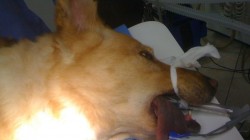
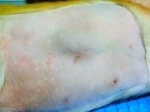
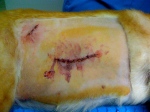
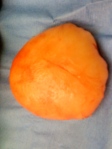
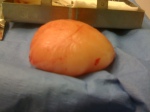


I really appreciate how you explain both the worst case scenario and the best case. As a dog owner, 3 hrs. from a vet over bad roads, I’m super-vigilant. It helps to know what is probably “ok” and what I need to worry about (I normally err on the side of caution!). Right now I’m concerned about a tail lump that was aspirated 2 mos. ago. Vet found no scary cells so we will continue to monitor. So far so good.
Thank you, Carolyn.